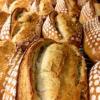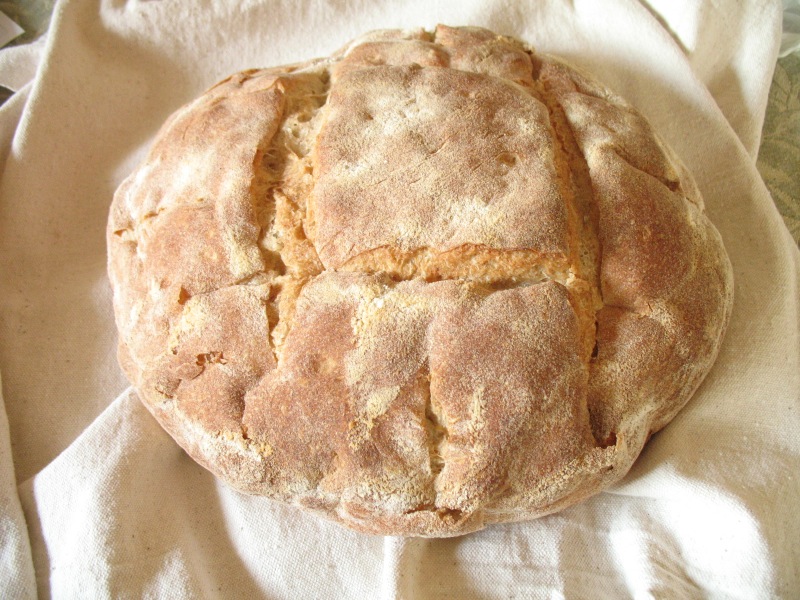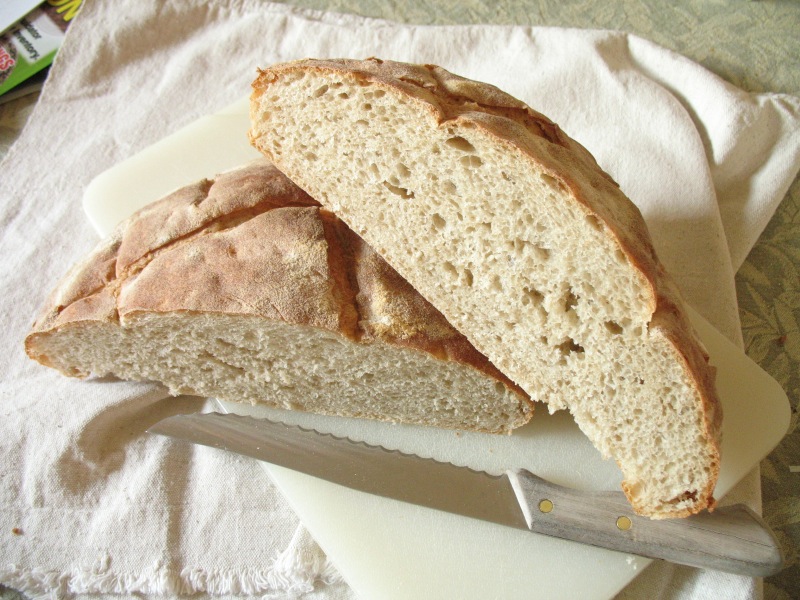
Round Seven: Round Indeed.
(From the blog)
It's been a short while since I've updated the blog so here's the latest which was actually made last weekend, June 14th.
This time around, I went with a round bread to see how that would work. Since I still don't have a banneton, I made do with a rice-flour coated, couche-lined sieve. By using a sieve, as opposed to just a bowl, I figured it would allow for some air transfer and keep the couche/canvas from getting damp and tacky. It pretty much worked, although it was still a bit tacky and pulled the dough ball a little when I transfered it to the baking sheet. I did not use the tiles this time, just to see how it would turn out and also to help conserve a certain amount of energy heating them for 45 minutes ahead of time (besides, it was already a pretty hot day, no sense heating up the kitchen even more). 
The worry here was that the ball of dough would collapse and turn into a giant disk and not a proper "boule" or ball. Well, it did a bit of both. The soft dough rather spread out once it was on the baking sheet but perked up a bit and rose up during the initial time in the oven. Yes, I'm still guessing what the oven temp actually is, have not yet found a reasonably priced decent oven thermometer.
So again spending the entire time watching the progress and giving the bread a spin halfway through the cooking time, here's the result. (Click pics to enlarge.)
So, let's critique.
The crust this time is thinner which meets with Mark's approval. As per the 'quick" version of the recipe, the dough proofed for only 2.5 hrs so it's not very sour - not necessarily a bad thing. The slashing, well... that definitely needs work still. After I made the first cut, the dough ball rather lost it's firmness and spread out a fair bit so I was a little reluctant to slash too heavily for the other three cuts. The crust looks rather lumpy/crater-ish and not very tight and smooth. I don't know what causes that or how to remedy it. Yet. It could likely have stood a slightly longer baking time to get a bit less... anemic looking.
The crumb is light, not chewy, again this has received good reviews from the white sliced bread fan. In fact I have to admit that there was another loaf, a batard, that never got a chance to get photographed as it vanished pretty darn fast. That one got a brushing with butter as soon as it came out of the oven so the crust there was even more like packaged bread. It was tasty but the butter did not all soak in, so the loaf was a little oily to handle. Since it vanished in about a day, I guess it wasn't a big issue. ;)
So again, we have a successful bake (i.e. nothing burned or flattened like a pancake) with a few minor adjustments to look into:
1) How to keep the boule from flattening too much both before and with the slashing
2) What's the deal with the lumpy crust and why isn't it a nice, tight outside?
3) Considering both points #1 and #2, would a tighter crust translate into a chewier crust? Hmmm..
More rounds to go before these issues are settled.




Comments
The crust issues look like it might be a combination of one or more of:
1) insufficient gluten development,
2) poor shaping,
3) overproofing
Basically, when you shape the dough, you really want to develop a nice tension on the top of the loaf. For larger boules, I typically do this by "tucking" the edges of the loaf under until I get a nice, tight surface. Yeah, this means the bottom isn't all nice and smooth, but it does the job. And if the gluten isn't sufficiently developed in the dough, it won't be able to hold that tension (you'll inevitably get some spreading, but it shouldn't noticeably flatten out, at least in my experience).
Meanwhile, overproofing can result in 1) a breakdown of gluten, and more importantly 2) yeast that has exhausted the food in their immediate vicinity and can no longer do their thing. The consequence is weak oven spring, which generates the nice, tight, puffed-up look of a well-baked loaf.
So, what was your schedule with this one? Did you window pane test it before bulk fermentation? How did you shape it? How long was the bulk fermentation and proofing stages after shaping? And how did you actually bake it up (temperature, humidity, etc, can make a small, though significant difference in the level of spring you get)?
Incidentally, your descriptions of the dough behaviour after slashing *really* sounds like overproofing to me... following slashing, the dough shouldn't noticeably deflate or lose it's structure. It may spread out a bit as the slashes begin to open up, but since slashing should be done right before baking, that effect should be minimal and compensated for by oven spring.
I followed the instructions for this recipe from the Wild Yeast Blog which says to ferment for 2.5 hrs with three stretch and folds every 55 min., then form into loaves and proof for another 2.5 hrs.
I did windowpane after the 3 min power knead in the KA mixer (wich is after the 30 min autolyse).
Temp... well, that's a problem. The oven gauge is a liar and so is the cheap little dial oven thermostat. But best guess is it was at about 430-450 for the first five minutes then down to about 420 for the rest.
Pan with 1 cup boiled water in the bottom of the oven, removed at the 10 minute mark. Couple of squirts of water onto the hot oven walls for instant steam too.
Folding method: tucking, as you suggest.
--------
Paul
Well, that's pretty average for a sourdough (heck, the bulk ferment is actually a touch on the short side).
Any idea on what the protein content is of the dough? Did you use AP? Bread flour? Certainly, the stuff I use is Canadian AP, which, AFAIK, has a minimum of 13% protein, which is fairly strong.
Then again, if the dough passed the window pane test, in theory, it should be strong enough. That said, you could do a bit more kneeding at the outset (I typically do a 20 minute autolyse, 5 minutes kneeding, 10 minute rest, then 5 more minutes... probably a bit excessive, but you can't really overkneed (well, other than kneeding to the point of oxidization the dough)).
BTW, how active is your sourdough starter? Is the volume doubling in the alotted fermentation/proofing times? I'm curious if, perhaps, the yeast isn't strong enough to generate a nice oven spring.
All purpose "yellow" brand unbleached. Although in another thread, Mike Avery said the way the protein is measured in the US vs in Canada, they are actually the same even though ours is labelled "13%" by law.
Stater has no problems doubling or even trippling.
I shall give extra kneading a try next round.
--------
Paul
Meh, might as well throw one more out there. What temp is the dough being fermented at?
79ºF (26ºC) in the kitchen that day.
--------
Paul